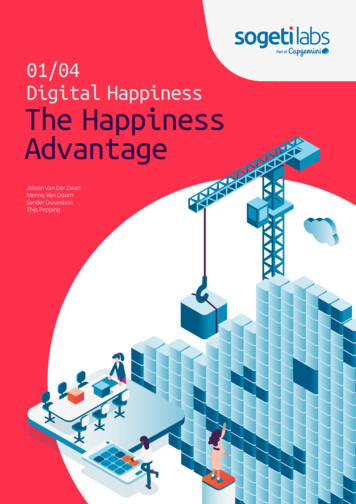
Transcription
01/04Digital HappinessThe HappinessAdvantageJoleen Van Der ZwanMenno Van DoornSander DuivesteinThijs Pepping
Why read this report?Digital happiness is rapidly becoming the newfrontier of competition. New digitalopportunities can make our lives easier, moreefficient, safer, and more joyful. You may askyourself where to begin and which needs toprioritize, but one thing is clear: onlyfocussing on efficiency and effectivity is notenough anymore. Customers and employeesare already two steps ahead by actually livingin a happiness economy. They are becomingmore selective when looking for happinessand a purpose, making the prudent use oftechnology an additional differentiator. Theirfindings and judgments are shared in reviewsand ratings, giving helpful insights forshopping customers who need thesehappiness ratings. Enhanced by a customercentric mindset, it is experience and emotionthat are today’s differentiators. Technologyempowers organizations to understand theseemotions, to persuade people with hyperpersonalized touch points, and to directlyimpact their happiness and sadness. Thosewho miss this societal trend will have a hardtime winning the hearts of the customer andnew employees. The advanced state ofdigitization today requires a holistic approachwith the ultimate question in mind: what is themain goal of the products, services, andorganization and how do they contribute tothe digital happiness of the customer?In this report we explore three key questions.First, what is the potential advantage ofaiming for happiness? Second, how doesdigital technology impact our individualhappiness? And third, what role mustorganizations play as guardians of thehappiness of their customers and employees?Key takeawaysDigital happiness:the competitive edgeThe gap between what is already realizeddigitally and the remaining possibilities isbig. This means there are still a lot of oppor tunities to better serve customers andemployees. This is utterly important, sincehappy customers are more loyal, makebetter references, increase an organization’sprofitability potential and enhance itsemployee’s productivity and sense of purpose and confidence. There is clearly ahappiness advantage to gain, which is whydigital happiness is becoming the new frontier of competition.Digital technologies influencehappinessResearch shows a strong impact of digitaltechnology on happiness. That impact canonly be understood through the couplingand decoupling powers of digital. In thatsense digital is different of othertechnologies. Without understanding theimpact of these powers on people’shappiness, every happiness strategy isdoomed to fail. The emerging specializedfield of Positive Technology identifies sixdigital happiness determinants which canhelp in such a strategy: Autonomy,Compassion, Competence, Engagement,Meaning, and Relatedness. An organizationthat takes the digital happiness of theircustomer seriously, must take these factorsinto account in its decisions regardingtechnology investments.Be(come) the guardian of yourcustomer’s digital happinessBy clearly understanding the role you playregarding the happiness of your customer,you’ll know what to do. By envisioning,designing, and quantifying for happiness,you will go beyond customer obsession andbuild the trust required to become theguardian of your customer’s digitalhappiness.
contentsIntroduction0041008010013016019Envision: The Happiness AdvantageRiding the wave of (digital) happinessDigital happiness is going beyond customer obsessionThe economic advantage of happinessShifting from economics to eudaimonics2Dealing with Delusions: Digital Is DifferentThe 7 paradoxes of digital happinessOur inability to deal with digital3Design: Hacking HappinessSchool of yesterday: experience and enterprise designSchool of today: Positive Computing & Time Well SpentSchool of tomorrow: beneficial AI4In conclusion: the future of measuring happinessBecoming the Guardian of Your Customer’s Digital Happiness040Quantifying happiness in societyNotesAttribution-NonCommercial-ShareAlike 3.0(CC BY-NC-SA 3.0)003026026026030032033037038Quantify: Measuring the Happiness EconomyMeasure to the max5020022024042We would like to thank all the experts we spoke to for their insights andinspiration, in particular Luciano Floridi (Director of Research, Professor ofPhilosophy and Ethics of Information), Claudi Senik (Professor of Economicsof Happiness at Paris-Sorbonne University), George Colony (CEO of ForresterResearch), Andrew Keen (author of How to Fix the Future), Gerd Leonard(Humanistic Futurist), Witte Hoogendijk (psychiatrist, professor and head ofthe Psychiatrics department at Erasmus MC, Rotterdam), Peter Leyden(founder and CEO of Reinventors), Esko Kilpi (senior adviser at Sitra), JoeGladstone (Assistant Professor of Behavioural Economics and ConsumerPsychology at University College London), Christiaan Triebert (investigativejournalist at Bellingcat), Risto Lähdesmäki (CEO and founder of Idean), KarinVan Baardwijk (COO and member of the Executive Committee of Robeco),Tim Canon (entrepeneur and biohacker). The aforementioned persons arenot responsible for the contents of this report.
IntroductionA countryside retreat, a fireplace, comfortable sofas, an executive team, and no clear agenda.We were invited to this extraordinary setting to discuss the future of banking with a financialinstitution’s management team. We already knew the team, the COO, the CIO, the LeadArchitect, and the CTO from previous discussions. We had been in the room before. Whileboardroom members from all over the world visit the Singularity University in Silicon Valley tolearn to “Think like Musk”, we were thinking “What would Elon do when he was here?” We hada nice view over the park, old paintings on the wall, and books everywhere. The place wasowned by dukes for centuries, then turned into a monastery 150 years ago, and nowadaysfunctions as a conference center. It has championed reinvention and survived transformationsin society for centuries. Here we were to discuss the reinvention of the banking industry. Afterhalf an hour of small talk, the discussion slowly took a certain direction. The COO raised hishand and said: “OK, we have the agenda. Let’s discuss two key issues: autonomy andcompassion.”Does it make sense to discuss compassion andBecomingthe guardian ofautonomy, basic human needs, while we couldhave talked about technology for the rest of theafternoon? We think it does. The two topicsdigital happinesswere familiar to us – they are part of the newPositive Computing trend: making humans moreThis Executive Introduction is the firstin a series of four reports about thenew trend of IT-humanism that is partof our “In Pursuit of Digital Happiness”research project. At this stage, weinterviewed more than 30 experts inthis emerging field, organized twointernational conferences and heldmultiple executive diners andworkshops to discuss the importanceof digital happiness in organizationalstrategies.happy through the use of technology. We hadjust arrived back from Chicago, where we spenttime with neuroscientists, behavioral experts,technology analysts, designers, body-hackers,and other independent thinkers to discuss thefuture of digital and how it could serve ourhuman needs. Among them was Andrew Keen,sometimes referred to as the “Antichrist ofSilicon Valley”. He gave us a pre-reading copyof his new book. “Let me know what you thinkof it” he said, “It will be published in a fewmonths”. The book’s title was How to Fix theFuture, discussing digital things that needed tobe fixed: a whole lot of them actually. Andrew’sfixing goes beyond organizations. Society as awhole, digital infrastructure, and how organizations and governments treat our data needs isto be reinvented.004
No matter how much needs to be fixed or reinvented, it has become clear that technology isnot only about technology anymore. We haveentered a next phase. We live in a world whereliterally everything can be coded. And anythingthat can be coded is becoming financially feasible. The only question that’s left is about basichuman needs. What do we truly desire? Whatare the new design principles that should guideus in this situation:#allyoueverdreamtoffcanbebuiltan exercise of listing all kinds of “computer -From a fireplace chat to deliveringdigital happinesssays-no” situations. Could a good shot ofIt is easy to come up with ideas, as we experi-empathy fix these situations and improve the lifeenced during our fireplace session. But greatof clients and employees? The empathy solu-ideas, in order to be implemented, need to betions suggested varied from simple nudges toenvisioned, quantified and designed. Thissome clever system workarounds. The paybackshouldn’t come as a surprise to you – it iswould be an increase in the net promoternothing more than common (business) sense.scored, a metric to gauge the loyalty of a firm’sUnderstanding what “digital” actually is, is lesscustomer relationships and their most importantclear. The realization that digital is different fromKPI. We were surprised to see how easy it wasother technologies is an important condition forto turn these high-level design principles into acreating happiness. The hopes of society, yourpragmatic plan. Satisfied with the work we did,customers, and employees that digital willwe thought we deserved a beer. And while theimprove their daily lives have never been higher.discussion continued, the topics slowly turnedBut delusions and digital paradoxes can spoilinto small talk again. Someone in the groupthe party. Your role as the guardian of digitalmentioned her upcoming 50th birthday celebra-happiness is to look one step ahead and guidetion; we discussed who was going to work onyour customers and employees through thisSunday and who definitely wasn’t; and whofoggy terrain.The discussion around the fireplace turned intowould take the kids to the hockey field. It suddenly became clear how easy it really is to behuman and how simple improvements in ICTsystems can benefit life.005
EQ-ID: four steps to digital happinessEnvision, Quantify, Install, Design. We took the acronym EQ-ID as a guide for our story,the chapters in the report, and as the underlying framework for action. This has much todo with the emotional intelligence of your company – getting better at listening to thevoice of the customer, for instance knowing what truly drives their happiness. The identity of your organization as happiness guardians is a serious attempt to strengthenhuman relationships: The EQ-IDentity as illustrated below.EnvisionThe Happiness AdvantageDealing withDelusionsQuantifyMeasuring theHappiness EconomyGuardianof Digital HappinessInstallDesignTaking away FrictionsHacking HappinessChapter 1:Digital is DifferentEnvision – The Happiness AdvantageClosing the gap between your current digital reality and digital possibilities is part of the“Happiness Advantage”. A long-term vision, even a 300-year strategy for your organization, will be discussed here.Action:Fulfill the current digital (peak) hopes, and do it fastChapter 2:Dealing with Delusions – Digital Is DifferentThe specific characteristics of digital technologies – the ability to cut and paste, todecouple and bring together realities in life – are changing the very essence of oursociety. Many aspects of digital life are unprecedented and unforeseen. We need abetter understanding of the whole landscape of digital impact, and this is an emergingand highly sensitive area.Action:Get the big picture: how digital is different006
Chapter 3:Design – Hacking HappinessHappiness starts with a good organizational and customer experience design. For designing happiness we’ll present the design principles of the school of today and the school ofthe future. The future school is concerned about what technology might bring tomorrowwhile the school of today wants to immediately seize the opportunities for improving ourcurrent lives.Action:Design for happiness and go beyond “customer obsession”Chapter 4:Quantify: Measuring the Happiness EconomySmiles on the faces of your customers do matter. Employees that go the extra mile, theflow of your organization, all these things matter. The fact is that we never measure themin the same obsessive way as we measure weekly sales or revenues per region. Butscience is catching up. Countries started measuring the happiness of their citizens, netpromotor scores find their way into reports, measuring the advocacy of a brand isbecoming popular, and so is sentiment analysis through social media. The message issimple:Action:Start to measure beyond daily salesChapter 5:Becoming the Guardian of your Customer’s Digital HappinessInstalling your happiness enhancers, and foreseeing and guiding your customers throughthe hopes and delusions of the new digital existence is key. Becoming the guardian of thedigital happiness of all people using your systems is thinking one step ahead. Tendenciesin society move towards these happiness fundamentals. We propose that the next step of“customer obsession” is putting the digital happiness of the customer (and employee)first, demanding human-centric as opposed to technology-centric, thinking.Action:Become a happiness guardian: anticipate on the fundamentalhuman needs007
1Envision: The Happiness Advantage“Whenever I feel lost, I look ahead, far ahead”Masayoshi SonOn June the 25th of 2010, Masayoshi Son, CEO of the Japanese SoftBank, presented hiscompanies’ 300-year strategy based on its corporate philosophy “Information Revolution –Happiness for everyone”.1 SoftBank, a multinational telecommunications and Internet corporation, is listed as the 39th largest public company in the world according to Forbes Global2000 of 2017.2 In Son’s vision, SoftBank’s reason for existence is to comfort people in theirsorrow. Topics like death, loneliness, and despair are his sources for inspiration. SoftBankwants to become “The corporate group needed most by people in the world”.“I want to increase people’s joy, to fulfill theirvision. The event wasn’t only about the launchneed to be seen, to learn, and to build relati-of a 300-year vision, it also was a party organi-onships”, is one of the highlights in Son’s talkzed to celebrate a new version of robotabout the future of his organization. The impor-Pepper. Maisonnier commented on that occa-tance of focusing on the emotional and humansion that he has always believed that the moststate is something we strongly emphasized inimportant role of robots will be – as kind andour report series on machine intelligence3. Andemotional companions – to enhance our dailySoftBank is very much into machine intelli-lives, to bring happiness, to constantly surprisegence and robotics. It is well known for itsus, and make people grow. The fact thatacquisition in 2015 of the French robotics com-Pepper now can “read” emotions was presen-pany Aldebaran Robotics, creators of robotsted as a new dimension in our lives offeringNAO, Pepper and Romeo. Both Son and Brunonew ways of interacting with technology. “It’sMaisonnier, Founder & CEO of Aldebaran, seejust the beginning, but already a promising rea-a logical fit between robots and SoftBank’slity” Maisonnier added, “Thanks to Pepper, theRobots will play their part in the new happiness strategy of SoftBank. Besides AldebaranRobotics in 2015, they also purchased Boston Dynamics in 2017 (previously owned byAlphabet). From left to right we see 1) Nao, Romeo, Pepper, 2) an artist impression of Romeohelping, 3) Atlas, 4) Handle and 5) Spot Mini.008
PhilosophyInformation revolution: Happiness for everyoneVisionThe corporate group needed most by peoplein the worldValuesTry hard, have funHappiness Strategy, SoftBank 2010At SoftBank there’s only one company value:“Try hard, have fun”. The famous anthropologistJohan Huizinga would have understoodSoftBank’s reasoning here. In his 1938 bookHomo Ludens he defines the essence of allhuman beings as “being playful”. Life is a gamein which the Homo Ludens walks around and hasfun. Happiness in that sense comes close to whatHuizinga defined as essential in humanexistence.5future begins today and we want all of you tobe a part of it.”4 NAO, Pepper and Romeohave seen their first gigs in healthcare and ascompany hosts.SoftBank is leading the pack with their (Digital)Happiness vision and strategy and are aimingfor the moon. Besides robots they are alsoworking towards a symbiosis between humankind and computer and are heavily investing incompanies that have similar future visions.Everything starts with a happinessculture @ Zappos3 TYPES OF HAPPINESS AT ZAPPOSAnother company with a unique happiness visionHappinessis online e-tailer Zappos. Their CEO, Tony Hsieh,is well known for his commitment to companyculture and is an advocate for self-organizationin a so-called “Holacracy” (as we explained inHigher PurposeMeaningBeing part of somethingbigger than yourselfPassionour report The Unorganization6). Zappos startsFlow and EngagementTime flieswith a higher purpose and then works towardspassion and pleasure. The company leveragessocial media as the key digital technology toPleasurecreate happiness. They aim for real, personalRock StarChasing the next highsocial conversations and stories, shared byemployees and customers alike.rtte cheb ae roTh ppa’slepheo act pprosoM apTime009
Riding the wave of (digital)happinessAligning interests @ LemonadeA third case of envisioning comes from theinsurance world. Perhaps you have heard aboutLemonade, a peer-to-peer insurance startupJust a decade before Son presented his happi-based in New York. The company is claiming theness strategy, happiness took off. Marketingabsolute world record for speed for paying outand consumer specialist Dr. Alexandraa claim. They have paid a customer’s claimGanglmair-Wooliscroft calls it the H-market:within 3 seconds of filing it and with zero paper-“Most publicity for consumption productswork, partly thanks to eighteen anti-fraud detec-appeals (consciously or unconsciously) to ourtion algorithms. Besides their high-techquest for happiness. The H-market is boomingapproach to the insurance industry, the– as every marketer knows.”10 It all started withcompany has an interesting vision regardingthe books and speeches by psychologists likehappiness: you can’t create happiness for theMartin Seligman on “authentic happiness”,customer if it isn’t in your own interest. Dan“well-being” and “eudaemonia”. A new scienceAriely, Professor in Psychology and Behavioralwas born late 20th century, called “PositiveEconomics, and Lemonade’s Chief BehavioralPsychology”. While old school psychologistsOfficer explains: “Every dollar your insurer payslooked at people with mental problems to beyou is a dollar less for their profits. So whencured – a negative view – this new school tooksomething bad happens to you, their intereststhe insights from psychology to improve every-are directly in conflict with yours. You’re fightingone’s life, a positive view. The popular mediaover the same coin.”7 Ariely suggests replacingquickly jumped on the bandwagon: books, tele-the word “marketing” with the phrase “con-vision programs and magazines on happinesssumer well-being.”8 And since we’re alreadyfollowed. The trend spread quickly throughoutplaying a word game, we can easily addculture, the economy and businesses. Humanemployee and planet well-being. In the end it’sresource management introduced the “Chiefthe happiness of the whole value chain whichHappiness Officer” (without much success,decides the happiness of humanity. Contractingunfortunately). It appeared that it takes morebehavior scientists like Dan Ariely can be a sig-than a fancy name on a business card to getnificant step in the realization of a “do the rightthings done.thing” philosophy. Lemonade has the vision andmission to change this model of conflictingThen, in the early 21st century, the economistsinterests by reserving 20 percent of the premi-started to measure happiness. The notion ofums to cover their costs including a modestGross National Happiness (GNH) was firstprofit. So far Lemonade is doing pretty well,introduced by the government of Bhutan. Thisexpanding their operations beyond New York tois an index that is used to measure the collec-Illinois and California, and claiming as much astive happiness and well-being of a population.27 percent market share for newcomers to theThe Gross National Happiness is instituted asmarket in New York in2017.9The previouslythe goal of the government of Bhutan in thediscussed SoftBank recently investedcountry’s constitution, enacted on 18 July 120 million in Lemonade, aligning their own2008. In 2011, The UN General Assemblystrategy with that of Lemonade.passed a resolution “Happiness: towards aholistic approach to development”, urgingmember nations to follow the example of010
Happiness as a theme is permeating thetech world. A brief selection of booksshows the following:1) The Dalai Lama (who visited SiliconValley), 2) Zappos’ happiness culture,3) The Google-born mindfulness trainingand philosophy “Search inside yourself”,4) Solve for Happy: Engineer Your Path toJoy, a book in which Mo Gawdat, ChiefBusiness Officer for Google X, sets thegoal to make one billion people happy,5) The scientific approach of digitalhappiness finds it roots in PositiveComputing and 6) Cyber psychology,7) Homo Deus contains futuristic forecastsby historian Yuval Noah Harari about ourincreasing happiness pursuit.Bhutan and measure happiness and well-beingand calling happiness a “fundamental humangoal”. And nowadays happiness (or sadness)can be found as smileys next to product placements everywhere on the internet. Expressinghow we feel about a product or service hasbecome daily routine: we are living in the happiness economy. Just recently computerscience started noticing the importance ofwell-being and happiness. The lessons frompositive psychology are now being applied in anew domain called Positive Computing.Safeguarding human happiness (the H-market)is booming, and it is unlikely it will disappearfrom the agenda ever again. With the power ofartificial intelligence in mind, a “positive”approach to everything we digitize becomes Learning breakthrough: Deep learning algo-essential, as we now can build anything we canimagine.rithm AlphaGo learned how to play chess ona super human level in just 24 hours, withoutWhat do we want?any assistance.11 We’re getting closerSo how did we end up discussing empathy andtowards generic thinking machines. Performance breakthrough: Chineseautonomy with the executive management ofthis financial institution in the old monastery wecompany Yitu Technology built a systemmentioned in the introduction? The whole ideacalled Dragonfly Eye that recognizes anyabout technology not being the issue anymoreperson walking on the street withinresulted from our recent research project on3 seconds, out of 1.8 billion people in theirartificial intelligence. Our 25-year journey ofdatabase. Something like this was unimagi-analyzing the impact of new technologies boilsnable ten or even three years ago.12 Economic breakthrough: The number onedown to one important conclusion: now it isdifferent. We’ve built the digital infrastructure,determinate of economic growth in thissociety is connected, and artificial intelligence isdecade is digital and to be more specific,now pouring into our highly automatedartificial intelligence. Programmable intelli-economy. Digital is lifting society to anothergence will change our economy and societylevel. Some recent accomplishments:rapidly in the coming decades.011
”Imagine being asked whetheryou are online by someonewho is talking to you throughyour smart phone, which islinked up to your car soundsystem through Bluetooth, whileyou are driving following theinstructions of a GPS, which isalso downloading informationabout traffic in real-time.”13We can make this list as long as we want. It willall add up to the conclusion that there’s anenormous amount of untapped digital territoryahead of us. Combining these new possibilitieswith age-old human desires is the new cuttingedge. Freed from the limiting factors of technical and financial realities, the discussion shiftsto the question of social desirability. Put succinctly by Sherry Turkle, professor of SocialStudies of Science and Technology at MIT:“What do we want?”For thinkers as Yuval Harari, Luciano Floridi, andThe clear distinction between digital andAaron Hurst the answer to “What do we want?”non-digital life finally can’t be made anymore.is simple: people want more happiness and pur-And when that happens, what makes us digitallypose. In his recent book Homo Deus: A Briefhappy can only be expressed by the differentHistory of Tomorrow, Israeli professor and histo-life experiences, like in traffic, education, leisure,rian Yuval Harari, presents happiness as theworking life, family life and without using themain objective of humanity in the 21st century.word digital anymore.Harari explains that technology, and specificallyartificial intelligence, will ironically lead usA question still left to be answered is “What istowards a more human-centric society andHappiness exactly?” As we will see in the nexteconomy. More human-centricity leads toparagraph, there are more dimensions of happi-design concepts like empathy and autonomy,ness. Everyone has his own opinion since we allexactly the values we talked about in the futureare so familiar with it. We asked Luciano Floridiof banking session.for his definition of happiness. He told us thathappiness is the incremental fulfillment of hope,Luciano Floridi, professor of philosophy andand even supplied us with a formula for hope:ethics of information at Oxford University, hassimilarly argued that information and communication technologies (ICTs) are not as muchabout technology as they are about how theyare reshaping human reality – which will lead toIn this formula hope is the desire for what onethe human project. He further advances thebelieves is probable. H Hope, D Desire,proposition that offline or online is no longer aB Belief, a attribute, the thing one hopes for,useful distinction: we are onlife. We increasinglyone desires, or one believes in, and p thelive in that special space that is both analog andprobability. This is in line with William James’digital, both online and offline.perspective: “Our happiness seems to requirethat we have ideals, that we strive to achievethem, and that we think we are making someprogress towards doing so.”012
Digital happiness is goingbeyond customer obsessionOr simply put: Floridi’s formula is the essence ofconsumer behavior and marketing. Marketerscreate the desires for, let’s say, the new featureson the smartphone by making us believe ourThe Dalai Lama XIV, often laughing or smiling,lives will be easier, better, and so forth with thatstands in a long tradition from Buddhists toproduct. Fulfilling that hope, buying the product,philosophers who claim the purpose of life isand delivering upon that belief, would actuallyhappiness. In his book The Art of Happiness hemake people happier. So, what can we alreadypredicts: “the very motion of our life is towardslearn from this somewhat unconventional defini-happiness.”14 The commercial derivate of thistion of happiness and the status quo of digital?insight is old wisdom: making sure that customers are happy so that they keep coming back. Beliefs in what technology can bring areOne can say it’s the basis for doing long-termstrong. We are experiencing a digital “peakbusiness and it’s evident that there is an eco-hope”.nomical advantage to be gained when aiming Customers and employees will be knockingfor happy customers and happy employees.on your doors, asking for better digital ser-This trend, the high focus on the customer andvices.his or her happiness, is on the radar of many Hopes don’t live in verticals but spread hori-companies and is a prerequisite to becoming azontally across industries.leader in the digital happiness market. Forrester Hopes can be based on an illusion (as we’llResearch calls it the “Age of Customersee in chapter 2) and create unhappiness.Obsession”, highlighting extreme customer-centricity as the only way to meet the risingexpectations of the customer, newly empowered to switch to a competitor with a simpleclick, swipe, or text. However, as the bar continues to be raised, moments of delight aredegrading to nothing more than boring “musthaves”. When we asked George Colony, CEOof Forrester Research about the importance ofhappy customers, he gave us some clearfigures. “Our research has shown” he said,“that companies with excellent customer experience and happy customers drive revenue attwice the rate of companies with poor customerexperience and unhappy customers”. Colonyadded that it’s really about long-term happiness.For instance, their research shows that multiplecompanies that scored high on experience lastyear, dropped in scores this year, simplybecause the expectations of customers arecontinuously rising.013
onnectedS richgyolonhTecntsleTaTo become customer obsessed Forrester distinguishes four operational principles whichoverlay the six operational levers.What’s required to become customerobsessedHappiness definedCustomer obsession needs to be reflected instrategies often focus on giving the customeryour organization’s structure, culture, talent,positive emotions. This is a very good start, butmetrics, processes and technology. Forresterit turns out that the experts define happiness asdistinguished four operational principles tosomething more than only positive emotions.focus on when an organization wants to trans-These happiness experts are part of a special-form into a customer-obsessed organization:ized field in psychology, called Positivebecome customer-led, insi
Introduction 004 1 Envision: The Happiness Advantage 008 Riding the wave of (digital) happiness 010 Digital happiness is going beyond customer obsession 013 The economic advantage of happiness 016 Shifting from economics to eudaimonics 019 2 Dealing with Delusions: Digital Is Different 020 The 7 paradoxes of
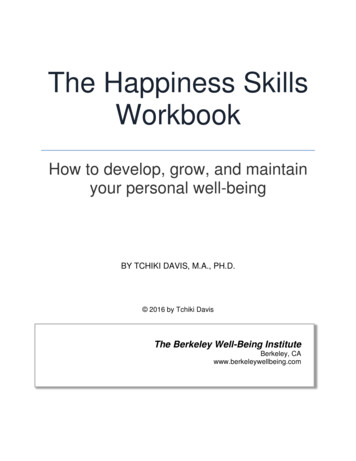

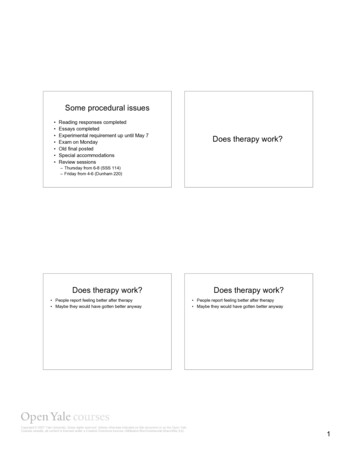

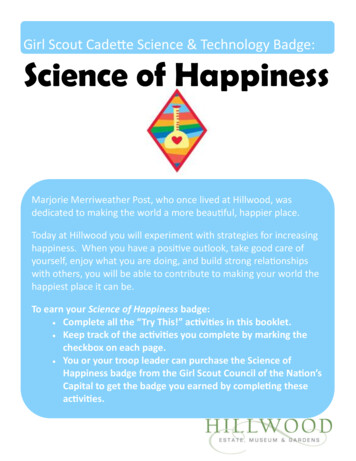



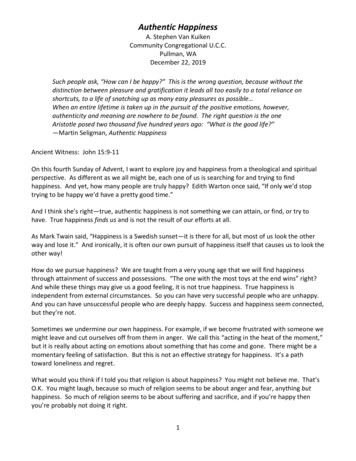
![INDEX [ actmindfully .au]](/img/14/2016-complete-worksheets-for-russ-harris-act-books.jpg)
![INDEX [thehappinesstrap ]](/img/14/complete-worksheets-2014.jpg)